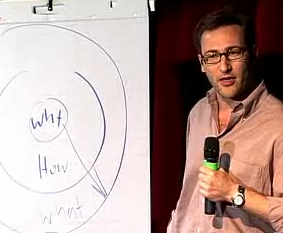TEDTalk Countdown: the #2 most-watched video on TED.
The Big Idea: People don’t buy what you do. They buy why you do it.
The overall construct of the speech: Persuasive, using logic, research and anecdotes
Not perfect:
His opening rhetorical question took me off-track at the start. “How do you explain when things don’t go as we assume?”
And, just when I was about to ponder that question, he came in quickly with another question. “Or better, how do you explain when others are able to achieve things that seem to defy all of the assumptions?”
The problem, for me, with the first question was that he just threw it out there, saying it quickly and then not having a pause for me to reflect for a moment. And the question was not specifically related to the topic of his speech. The second question was more related to his topic. He even tells the audience that with using the opening phrase, “Or better . . .” Why even bother with that first question?
Perhaps he wanted to build momentum with a series of rhetorical questions. Right after the second question he says, “For example: Why is Apple so innovative?”
Building momentum with three rhetorical questions is an excellent device, but I think he missed the boat with the first question.
A minor observation: he had a slightly distracting habit of pushing his glasses up. He did this more than a dozen times–which was not so often as to be highly noticeable, but as an eye glass wearer, I noticed it.
What he nailed:
Conversational style: His attire was casual (personally, I thought the jeans were too casual), his style was relaxed and his voice was soothing and resonant.
Persuasive Structure:
- Got attention with thought-provoking rhetorical questions and statements
(7 questions in the first minute. The statements also foreshadowed the examples he would expand on). This made the audience lean-forward mentally, anticipating the answers.
- Built suspense with “I made a discovery”
- Previewed his main point with “there’s a pattern . . . “
- Used a sexy title for his concept: “The Golden Circle”
- Used stories/examples to illustrate his concept (Apple, the Wright Brothers, Martin Luther King, Jr.). He also had a pattern to his story telling, contrasting failures and successes (Dell vs. Apple, Samuel Pierpont Langley vs. the Wright Brothers, TiVo vs. Dr. Martin Luther King Jr—well, that contrast was a bit of a stretch).
- Had a little bit of humor: He got a couple of laughs in this speech. My favorite was when he was talking about Dr. King. “And, by the way, he gave the ‘I have a dream’ speech, not the ‘I have a plan’ speech.”
- Repetition of a foundational phrase: He said this phrase seven times: “People don’t buy what you do. They buy why you do it.” The repetition of the phrase and its echo structure made it very memorable. He said it so often, that he could have had the audience chime in the last few times by starting the phrase for them “People don’t buy what you do . . . (motion to the audience to complete the phrase) . . . They buy why you do it.”
- Memorable visual: He only used a flip chart, and made some fairly quick and messy diagrams to illustrate a couple of concepts. It fit perfectly with his casual style and the physicality of his interacting with the flip chart was more personal than showing slides on a screen.
The Big Take Away: The idea of “start with why” is one speakers should well remember. Build your speech from the why of what you do and why your audience would care. Persuade in your presentations by focusing on the emotional “why” with reason and logic as supports.
Next week: The #1 most-viewed TEDTalk Ken Robinson “How Schools Kill Creativity”


hello
cool stuff
I agree with you that without decent pauses at the start, the pace was quite overwhelming. There was no time to think about what he asked, so no time to start opening up to his premise.
Later, his pace conveyed real passion and conviction. But early on, I felt listeners were left behind by it. So to me, building the pace instead (over a couple of minutes) would’ve been ideal.
If you’ve a moment, I’d really value your views on a critique of a TEDx talk on body language, which I recently published.
Anyway, really enjoying your posts, so thanks for sharing.